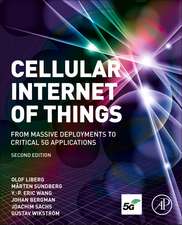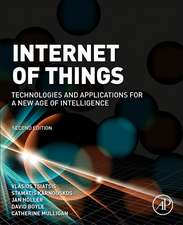5G Core Networks: Powering Digitalization
Autor Stefan Rommer, Peter Hedman, Magnus Olsson, Lars Frid, Shabnam Sultana, Catherine Mulliganen Limba Engleză Paperback – 13 noi 2019
Content includes:
- An overview of the 5G Core Architecture
- The Stand-Alone and Non-Stand-Alone Architectures
- Detailed presentation of 5G Core key concepts
- An overview of 5G Radio and Cloud technologies
- The differences between the 5G Core network and previous core network generations
- How the interworking with previous network standards is defined
- Why certain functionality has been included and what is beyond the scope of 5G Core
- How the specifications relate to state-of-the-art web-scale concepts and virtualization technologies
- Details of the protocol and service descriptions
- Examples of network deployment options
- Provides a clear, concise and comprehensive view of 5GS/5GC
- Written by established experts in the 5GS/5GC standardization process, all of whom have extensive experience and understanding of its goals, history and vision
- Covers potential service and operator scenarios for each architecture
- Explains the Service Based Architecture, Network Slicing and support of Edge Computing, describing the benefits they will bring
- Explains what options and parts of the standards will initially be deployed in real networks, along with their migration paths
Preț: 530.99 lei
Preț vechi: 784.43 lei
-32% Nou
Puncte Express: 796
Preț estimativ în valută:
101.62€ • 110.34$ • 85.36£
101.62€ • 110.34$ • 85.36£
Carte tipărită la comandă
Livrare economică 15-29 aprilie
Livrare express 18-22 martie pentru 142.41 lei
Preluare comenzi: 021 569.72.76
Specificații
ISBN-13: 9780081030097
ISBN-10: 0081030096
Pagini: 502
Dimensiuni: 191 x 235 x 29 mm
Greutate: 0.85 kg
Editura: ELSEVIER SCIENCE
ISBN-10: 0081030096
Pagini: 502
Dimensiuni: 191 x 235 x 29 mm
Greutate: 0.85 kg
Editura: ELSEVIER SCIENCE
Cuprins
1. Introduction
2. Drivers for 5G
3. Architecture overview
4. EPC for 5G
5. Key concepts
6. Session management
7. Mobility Management
8. Security
9. Quality-of-Service
10. Policy control and charging
11. Network slicing
12. Dual connectivity
13. Network functions and services
14. Protocols
15. Selected call flows
16. Architecture extensions and vertical industries
17. Future outlook
2. Drivers for 5G
3. Architecture overview
4. EPC for 5G
5. Key concepts
6. Session management
7. Mobility Management
8. Security
9. Quality-of-Service
10. Policy control and charging
11. Network slicing
12. Dual connectivity
13. Network functions and services
14. Protocols
15. Selected call flows
16. Architecture extensions and vertical industries
17. Future outlook




















